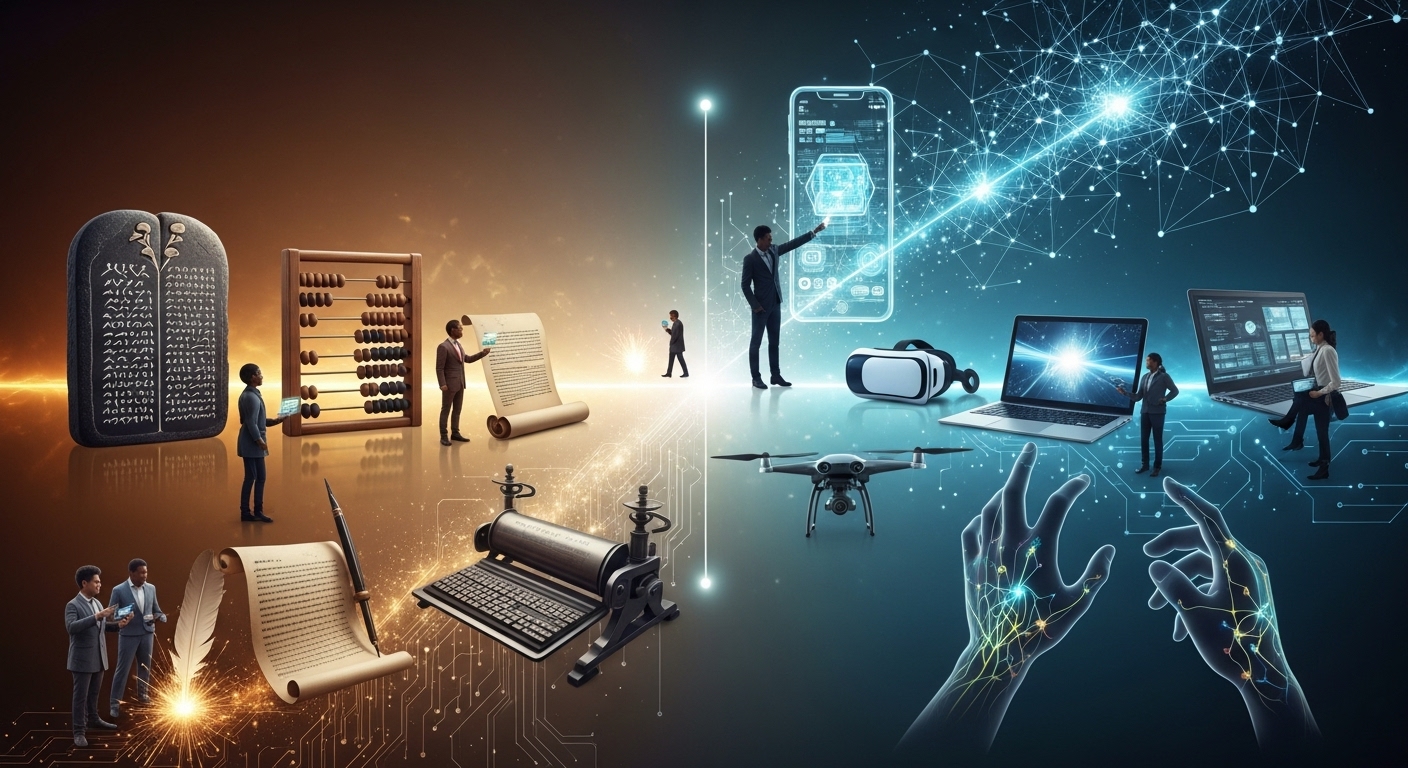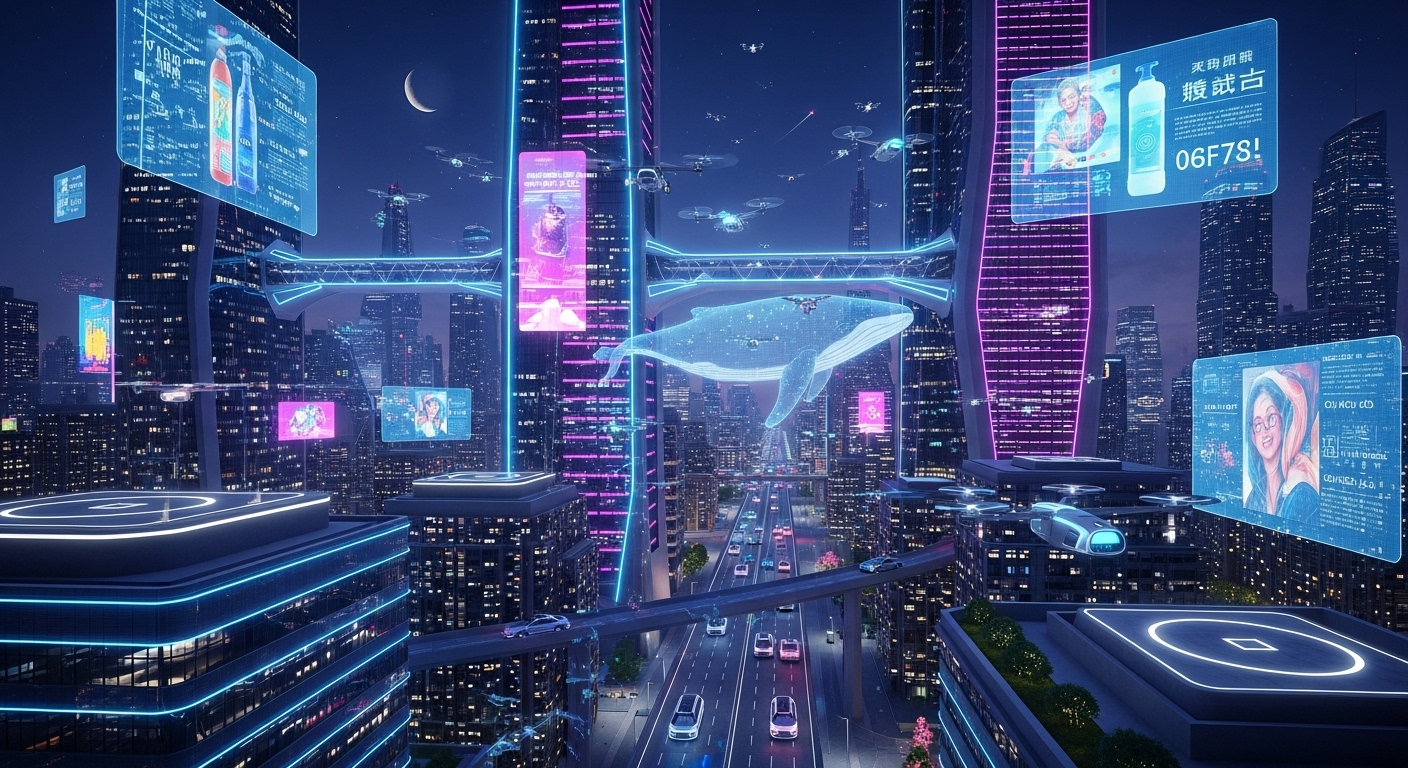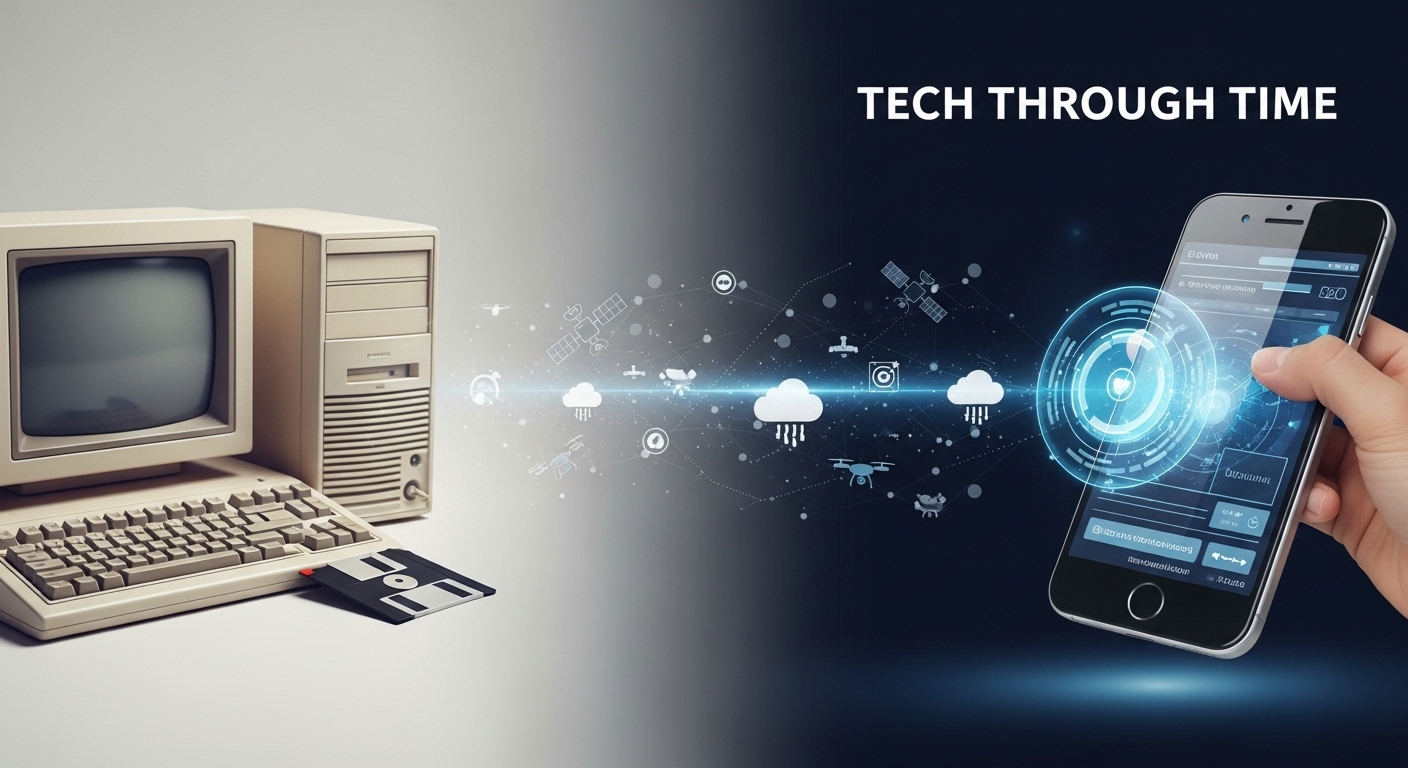Introduction
Technology has always been a fundamental part of human progress. From the invention of the wheel to the rise of artificial intelligence, technology reflects the human drive to make life easier, more efficient, and more connected. Each era of human civilization has been defined by the tools it created — from stone axes in prehistory to the smartphones in our hands today. As we move deeper into the 21st century, technology continues to evolve at a pace that challenges imagination.
This article explores the journey of technology from its earliest origins to the digital revolution and beyond. It examines how innovation reshapes societies, economies, and individual lives, while also reflecting on the ethical, environmental, and social implications of our tech-driven future.
The Roots of Human Innovation
Technology began not with circuits or machines, but with simple tools made of stone and wood. Early humans learned to manipulate their environment for survival — to hunt, build shelter, and protect themselves. These primitive technologies marked the beginning of human ingenuity.
The invention of fire was perhaps the most transformative development in early human history. Fire enabled cooking, which provided more efficient energy consumption, and offered warmth and protection. Later, the creation of the wheel around 3500 BCE revolutionized transport and agriculture, allowing humans to move goods and people more efficiently.
As civilizations grew, technology became central to progress. The Mesopotamians developed irrigation systems, the Egyptians built monumental pyramids using advanced engineering, and the Chinese invented paper and gunpowder. Every invention carried with it a ripple effect — transforming not only industries but also culture, communication, and power structures.
The Age of Industrial Transformation
The Industrial Revolution, which began in the 18th century, was a turning point in human history. It introduced machinery, mass production, and mechanized labor, changing the face of economies and societies worldwide. Steam engines powered factories, railways connected distant cities, and textile production shifted from manual labor to automated looms.
This era gave rise to capitalism as we know it and transformed rural societies into urban industrial hubs. Alongside economic growth came new challenges — pollution, labor exploitation, and social inequality. Yet the innovations of the time also laid the foundation for modern engineering, science, and education systems.
Electricity became the lifeblood of the second industrial wave. With the invention of the telegraph, telephone, and light bulb, communication and living standards soared. The late 19th and early 20th centuries saw breakthroughs in transportation with the invention of automobiles and airplanes, compressing time and space in ways that once seemed impossible.
The Digital Revolution
If the Industrial Revolution reshaped the physical world, the Digital Revolution redefined the mental and informational one. Beginning in the mid-20th century, the rise of computers transformed the way humans process, store, and share information.
Early computers were massive machines that filled entire rooms, built primarily for government and research purposes. Over time, technological advancements made them smaller, faster, and more accessible. The invention of the microprocessor in the 1970s paved the way for personal computing, leading to the creation of home computers that empowered individuals like never before.
The 1990s brought about another monumental shift — the birth of the internet. The internet connected the world in ways that were unimaginable only decades earlier. Email replaced traditional letters, search engines replaced encyclopedias, and digital media began to replace physical products. Information became democratized; anyone could publish, learn, and communicate globally.
The 2000s accelerated the digital age further with the rise of mobile technology. Smartphones combined the power of a computer, camera, and communication device into one portable unit. Social media platforms emerged, reshaping the way people interact, share experiences, and form communities. The world became not just connected but interconnected, forming what many call the “global village.”
The Rise of Artificial Intelligence and Automation
Today, the technological landscape is dominated by artificial intelligence (AI), machine learning, and automation. These technologies are not just tools but active participants in shaping decisions, optimizing systems, and performing tasks once thought uniquely human.
AI powers voice assistants, self-driving cars, recommendation systems, and medical diagnostics. It processes massive amounts of data to identify patterns and predict outcomes, improving efficiency in industries from finance to healthcare. Machine learning algorithms now curate what we watch, read, and buy, subtly influencing our daily choices.
Automation, meanwhile, has transformed manufacturing and logistics. Robots assemble cars, drones deliver packages, and algorithms manage stock markets. While this brings incredible efficiency, it also raises concerns about job displacement, privacy, and the ethical use of technology.
Technology and Society: A Double-Edged Sword
The impact of technology on society is complex — both empowering and disruptive. On one hand, it enhances communication, education, healthcare, and entertainment. On the other, it introduces new challenges, such as digital addiction, misinformation, and privacy erosion.
1. Communication and Connection
Technology has made global communication instantaneous. Video calls bridge continents, messaging apps connect families, and online communities unite people with shared interests. However, this constant connectivity also leads to digital fatigue. Social media, while empowering voices, can foster unrealistic expectations, anxiety, and polarization.
2. Education and Knowledge Access
Digital technology has democratized learning. Online courses, digital libraries, and educational apps make knowledge accessible to anyone with an internet connection. Yet, the digital divide remains — millions still lack access to reliable internet or modern devices, creating an imbalance in educational opportunity.
3. Healthcare Advancements
From robotic surgeries to wearable fitness devices, technology has revolutionized healthcare. Telemedicine enables remote consultations, and AI-driven diagnostics improve early disease detection. However, ethical questions about data security, patient privacy, and the role of AI in life-or-death decisions continue to grow.
4. Economic Transformation
Technology fuels innovation and creates new industries, but it also disrupts traditional sectors. Automation has replaced repetitive jobs, while new roles in data science and cybersecurity have emerged. The challenge lies in reskilling the workforce for the digital economy and ensuring equitable access to technological benefits.
The Environmental Cost of Technological Growth
While technology improves efficiency, it also has a significant environmental footprint. The production of electronic devices consumes vast resources, and e-waste has become a global issue. Data centers powering the internet consume enormous amounts of electricity, contributing to carbon emissions.
Technological progress must therefore align with sustainability. Renewable energy technologies such as solar and wind power are crucial for reducing dependency on fossil fuels. Innovations in electric vehicles, recycling systems, and biodegradable materials represent steps toward a greener future. Yet the key lies not just in invention, but in responsible consumption.
Ethics in the Age of Technology
As technology becomes more powerful, the ethical dimensions become more urgent. The rise of surveillance systems, data collection, and algorithmic bias poses new moral questions. Should machines be allowed to make life-altering decisions? Who is accountable when an AI system makes an error?
Privacy has become one of the most contested topics of the digital age. Every click, search, and message generates data that companies analyze to predict behavior. While this enables personalized services, it also exposes users to manipulation and breaches of confidentiality.
Another major concern is bias in artificial intelligence. Algorithms learn from data, and if that data reflects social prejudices, the results can perpetuate inequality. Ethical AI development requires transparency, accountability, and inclusivity to ensure that technology serves all of humanity fairly.
The Future of Technology: Where Are We Heading?
The future promises even greater transformation. Emerging technologies such as quantum computing, biotechnology, nanotechnology, and space exploration hold the potential to redefine life itself.
1. Quantum Computing
Quantum computers, capable of processing information in entirely new ways, could solve problems impossible for classical computers. From drug discovery to cryptography, quantum technology may unlock solutions that accelerate human advancement by decades.
2. Biotechnology and Human Enhancement
Genetic engineering, CRISPR technology, and synthetic biology are reshaping medicine and agriculture. These technologies could eliminate hereditary diseases, extend lifespan, and even enhance human capabilities. However, they also provoke ethical debates about the limits of human modification.
3. The Metaverse and Virtual Reality
Virtual and augmented reality are blending the physical and digital worlds. The concept of the metaverse — a persistent virtual universe — could revolutionize work, education, and entertainment. Yet, it also raises questions about identity, escapism, and the commercialization of human interaction.
4. Space Exploration and Colonization
Technology is extending humanity’s reach beyond Earth. Private and government-led missions are preparing for lunar bases and Mars colonization. The future may witness humans living and working beyond our planet, making space the next frontier of innovation.
Technology and Human Identity
As machines become more intelligent, humans are forced to reflect on what makes them unique. Are creativity, emotion, and consciousness truly beyond the reach of algorithms? Technology is not just changing how we live but challenging what it means to be human.
In a world where AI can paint pictures, compose music, and write poetry, the boundary between human and machine creativity is blurring. The question is no longer whether machines can think, but whether they can feel. While machines lack consciousness, their ability to simulate human behavior has profound implications for art, ethics, and self-perception.
Digital Minimalism and the Quest for Balance
Amid constant technological stimulation, many people are seeking simplicity and mindfulness. Digital minimalism advocates for intentional technology use — focusing on tools that add genuine value rather than constant distraction.
The movement encourages turning off notifications, limiting screen time, and prioritizing real-world experiences. In this sense, the future of technology is not just about advancement but about alignment — ensuring that innovation enhances, rather than dominates, human life.
Technology in Developing Nations
For many developing countries, technology represents both hope and challenge. Mobile connectivity, digital banking, and e-learning have opened new opportunities in regions once isolated by geography and poverty. Farmers use mobile apps to track weather and market prices; small businesses leverage e-commerce to reach global customers.
However, unequal access remains a major issue. Without proper infrastructure, digital literacy, and affordability, the benefits of technology remain concentrated in wealthier regions. Bridging this gap is essential for global progress. Inclusive technology — designed for accessibility and affordability — can empower communities and promote sustainable development.
The Human Side of Innovation
Behind every technological leap lies the human mind — curious, creative, and restless. Technology is not a force outside humanity but an expression of it. The engineers, scientists, and dreamers who push boundaries are guided by the same impulse that once drove our ancestors to make fire or carve tools.
Innovation is not only about creating new devices but about solving problems and improving lives. When aligned with compassion and wisdom, technology becomes a tool for social good — eradicating disease, reducing inequality, and preserving the planet. The key is not to fear technology but to guide it with responsibility and purpose.
Conclusion: Toward a Thoughtful Technological Future
Technology is neither good nor bad — it is a reflection of the choices we make. From the first spark of fire to artificial intelligence, every invention has carried the potential for both creation and destruction. As we stand on the edge of the next great transformation, we must ask not only what technology can do but what it should do.
The future will likely bring unimaginable advancements — intelligent machines, interplanetary travel, and enhanced human abilities. Yet, our greatest responsibility lies in ensuring that technology remains a servant of humanity, not its master.
The essence of progress is not measured by how powerful our tools become, but by how wisely we use them. Technology must evolve hand in hand with ethics, empathy, and environmental awareness. Only then can it truly serve its ultimate purpose — not to replace humanity, but to elevate it.



